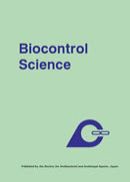All issues

Successor
Volume 9 (2004)
- Issue 4 Pages 89-
- Issue 3 Pages 43-
- Issue 1-2 Pages 1-
Volume 9, Issue 4
Displaying 1-5 of 5 articles from this issue
- |<
- <
- 1
- >
- >|
-
CHIZUKO MIYAKE-NAKAYAMA, SACHIYO MASUJIMA, HISAYOSHI IKATSU, SHIN-ICHI ...2004Volume 9Issue 4 Pages 89-93
Published: December 20, 2004
Released on J-STAGE: June 28, 2010
JOURNAL FREE ACCESSThe widely used organic solvent dichloromethane (DCM) has various toxic effects including carcinogenesis. We isolated a DCM-degrading bacterium Ralstonia metallidurans PD11 from drainage water which grew with DCM as a sole carbon source. PD11 was a methylotrophic bacterium with the ability to grow with C1 compounds such as methanol or methylamine. Although the existence of methylotrophic bacteria having DCM-degrading ability has been reported, there has been no report on Ralstonia sp. to date. The DCM-degrading activity of PD11 was increased by acclimatization, finally reaching a level to degrade 2, 500 mg DCM/I within a week. The cell-free extract of PD11 showed DCM-degrading activity by liberating chloride which was stimulated by addition of glutathione, suggesting that the DCM dehalogenationg enzyme could be classified into the glutathione S-transferase super family.View full abstractDownload PDF (803K) -
TADAO YABUHARA, TAKUYA MAEDA, HIDEAKI NAGAMUNE, HIROKI KOURAI2004Volume 9Issue 4 Pages 95-103
Published: December 20, 2004
Released on J-STAGE: June 28, 2010
JOURNAL FREE ACCESSWe synthesized a new bis-quaternary ammonium compound (bis-QAC), 4, 4'-(1, 6-dioxyhexamethylene) bis (1-alkylpyridinium halide) s (4DOBP-6-n-X) (alkyl chain length, n=6, 8, 10, 12, 14, 16 and 18, X=Br or I) that has a symmetrical dimeric structure, and is composed of two alkylpyridinium halides connected with a dioxyhexamethylene. We examined the relationship of the hydrophobicity and antimicrobial activity using 4DOBP-6-n-X. The influences of pH, temperature, and hemolytic activity were then measured using 4, 4'-(1, 6-dioxyhexamethylene) bis (octylpyridinium bromide) (4DOBP-6-8-Br) which showed a superior antimicrobial activity among the 4DOBP-6-n-X series. The following three chemical compounds were used as a comparison: 4, 4'-(1, 6-dithiohexamethylene) bis (octylpyridinium bromide) (4DTBP-6-8-Br) which is considered as an excellent antimicrobial agent based on a previous report, alkylbenzyldimethyl ammonium chloride (BAC) and 2-(4'-thiazolyl) benzimida-zole (TBZ). In the results of the experiment, 4DOBP-6-8-Br exhibited a wide antimicrobial spectrum, and had a strong activity against bacteria and fungi comparable to 4DTBP-6-8-Br. The hemolytic activities of 4DOBP-6-8-Br and 4DTBP-6-8-Br were almost same, and lower than that of BAC. 4DTBP-6-8-Br had some defects in that it colored metals or generated a bad smell and a hazardous gas; however, in 4DOBP-6-n-X, these disadvantages were not present. 4DOBP-6-n-X seems to be an environmentally friendly antibacterial agent.View full abstractDownload PDF (1238K) -
SATOSHI FUKUZAKI, HIROSHI HIRATSUKA, ATSUHIKO TAKEHARA, KAZUHIRO TAKAH ...2004Volume 9Issue 4 Pages 105-109
Published: December 20, 2004
Released on J-STAGE: June 28, 2010
JOURNAL FREE ACCESSAlkaline (AIEW) and acidic electrolyzed water (AcEW) were prepared by the electrolysis of a dilute sodium nitrate solution. The efficacy of AIEW (pH 11.5) in removing the gelatin deposited on stainless steel particles was compared with that of warm deionized water (DIW; pH 5.7) at various temperatures of 20 to 80°C. The efficiency of the DIW cleaning increased with increasing temperatures from 20 to 70°C, whereas it decreased to some extent at 80°C. On the other hand, the efficiency of AIEW cleaning increased with increasing temperatures up to 50°C, above which it decreased gradually. AIEW cleaning was shown to be by far more effective in removing gelatin than warm DIW cleaning, and its optimum temperature was 50°C. AcEW cleaning removed calcium hydrogenphosphate deposited on stainless steel particles, depending on the solution pH, and resulted in the modification of the surface charge of stainless steel particles, due to the oxidizing action of nitrate in AcEW.View full abstractDownload PDF (768K) -
HIROSHI MORITA, TSUBASA FUKUDA, HIDETAKA KAWAKITA, KAORI MAMITSUKA, MA ...2004Volume 9Issue 4 Pages 111-115
Published: December 20, 2004
Released on J-STAGE: June 28, 2010
JOURNAL FREE ACCESSRhizopus sp. MKU 24 selected from 46 Rhizopus strains produced a considerable amount of antibacterial activity in a liquid culture. The concentration and the kind of metal ion have large influence on the production of the antibacterial substance. It is concluded that the SLS medium supplemented with 2μg/ml of iron ions, 49 μg/ml of magnesium ions, 2.5 μg/ml of zinc ions, and 100 μg/ml of calcium ions was the best condition for producing the antibacterial substance. Antibacterial activity was not detected against Gram-negative bacteria, yeast, and fungi, but strong activity was detected against Bacillus subtilis and Micrococcus luteus.View full abstractDownload PDF (696K) -
WIN AUNG, NAING NAYLIN, ZHIBING ZHENG, YUKA WATANABE, FUMIO HASHINAGA2004Volume 9Issue 4 Pages 117-122
Published: December 20, 2004
Released on J-STAGE: June 28, 2010
JOURNAL FREE ACCESSA total of 33 bacterial strains from ngapl, a Burmese salted and fermented shrimp paste, were screened for antioxidant and antibacterial activities. Two strains, NP1-1 and NP3-2, which showed high free radical scavenging and antibacterial activities, were selected. Radical scavenging activities of the ethyl acetate extracts were compared with those of BHA using DPPH. The antioxidant activity of extracts was determined according to the thiocyanate method. Moreover, the filtrate extracts from the two strains were found to have broad inhibitory activity against target bacteria. NP1-1 and NP3-2 strains were respectively identified as Bacillus subtilis and Bacillus sp. based on the 16S rDNA sequences.View full abstractDownload PDF (2123K)
- |<
- <
- 1
- >
- >|